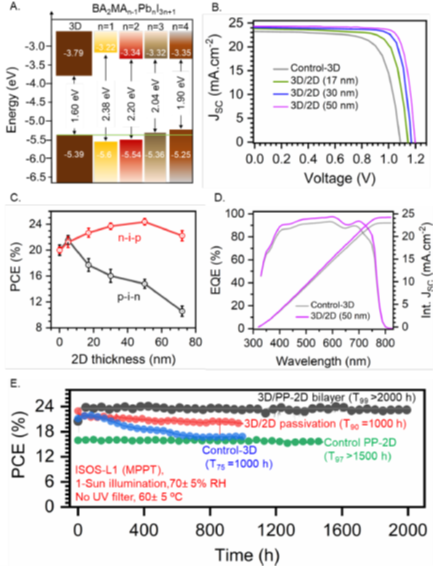Realizing solution-processed heterostructures is a long-enduring challenge in halide perovskites because of solvent incompatibilities that disrupt the underlying layer. By leveraging the solvent dielectric constant and Gutmann donor number, we could grow phase-pure two-dimensional (2D) halide perovskite stacks of the desired composition, thickness, and bandgap onto 3D perovskites without dissolving the underlying substrate. Characterization reveals a 3D–2D transition region of 20 nanometers mainly determined by the roughness of the bottom 3D layer. Thickness dependence of the 2D perovskite layer reveals the anticipated trends for n-i-p and p-i-n architectures, which is consistent with band alignment and carrier transport limits for 2D perovskites. We measured a photovoltaic efficiency of 24.5%, with exceptional stability of T99 (time required to preserve 99% of initial photovoltaic efficiency) of >2000 hours, implying that the 3D/2D bilayer inherits the intrinsic durability of 2D perovskite without compromising efficiency.

Photovoltaic performance and long-term stability of the 3D|PP-2D(BA2MA2Pb3I10) HaP bilayer solar cells. (A) Energy-level alignment for different n-values (n≤4) of 2D perovskite with the 3D perovskite layer with an error of ±0.05eV. (B) Current voltage curves of the champion 3D/PP-2D n-i-p PSCs as a function of the 2D layer thickness obtained by spin coating different concentration of the 2D perovskite solution in MeCN. (C) Variation in PCE of the n-i-p and p-i-n planar 3D|PP-2D PSCs as a function of 2D perovskite layer thickness. (D) External quantum efficiency of the device with and without the 2D layer, showing the absorption and current generation ability of the stack. (E) ISOS-L-1 stability measured at maximum power point tracking in ambient condition under continuous 1-sun illumination (55 ̊C) for an epoxy encapsulated PSC. The initial PCE of the control device is 21%, the 3D|2D passivated device, 22.93%, the 3D|PP-2D bilayer PSC, 23.75% and the PP-2D perovskite device is 16.3%.
Article published in: Science